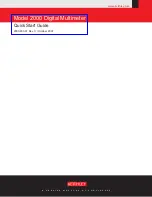
1-4
Return to
Section Topics
2000-903-01 Rev. C / October 2007
Section 1: Introduction
Model 2000 Digital Multimeter Quick Start Guide
Storing readings (2 to 1024)
1.
Set up the instrument for the desired configuration.
2.
Press the STORE key.
3.
Use
the
,
,
▲
and
▼
keys to select the number of readings to store in the buffer.
4.
Press ENTER to start the storage process. The asterisk (*) annunciator turns on to indicate
a data storage operation. It turns off when the storage is finished.
Recalling readings
1.
Press the RECALL key. The BUFFER annunciator indicates that stored readings are being
displayed. The arrow annunciator indicates that more data can be viewed with the
,
,
▲
and
▼
keys.
2.
Use
the
,
,
▲
and
▼
keys to navigate through the reading numbers, reading values, and
statistics. For any of the buffer statistics (maximum, minimum, average, standard deviation)
the STAT annunciator is on.
3.
Use the EXIT key to return to the normal display.
Changing speed, resolution and filter
RATE
— Measurement speed (reading RATE) can be changed for any measurement function
except frequency, period, continuity and diode test. Use the RATE key to select FAST, MEDium or
SLOW. Use FAST (0.1 PLC) if speed is of primary importance (at the expense of increased noise
and fewer usable digits of resolution). SLOW (10 PLC) provides better noise performance at the
expense of speed. MEDium (1 PLC) provides a compromise between noise and speed.
DIGITS
— Display resolution can be changed for any measurement function. Use the DIGITS key
to select the desired number of digits (3 to 6 ).
FILTER
— Filter state (on/off) and configuration can be changed for any measurement function,
except frequency, period, continuity and diode test. The FILTER key toggles between filter on
(FILT annunciator on) and filter off. After pressing FILTER to enable the filter, you can then enter
the filter count (1 to 100), and select the filter type (moving or repeating). (If the FILT annunciator is
already on, press FILTER twice before entering the filter count.)
Changing temperature measurement configuration
Press SHIFT and then TCOUPL. Three choices are available using the
▲
and
▼
keys:
•
UNITS — C, K or F. Specify units.
•
TYPE — J, K or T. Specify thermocouple type.
•
JUNC — SIM or CH1. Simulate a reference junction temperature (for direct thermocouple
connection to the INPUT), or use the reference junction (channel 1) provided on a switching
card. In order to keep the reference calculations updated and accurate, Channel 1 needs to
be read periodically.
To assign a value to a parameter, use the
▲
and
▼
keys to scroll to the desired parameter. Select
the
key, and use the
▲
and
▼
keys to scroll through and choose the preferred value. Select the
ENTER key to save any changes.
Relative (rel)
Rel can be used to null offsets or subtract a baseline reading from present and future readings.
When rel is enabled by pressing REL (REL annunciator on), the instrument uses the present
reading as the relative value. Subsequent readings will be the difference between the actual input
value and the rel value. You can define a rel value for each function. Pressing REL a second time
disables rel.






























